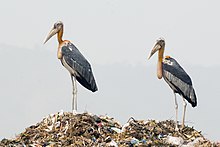
Back أبو سعن الكبير Arabic ابو سعن الكبير ARZ হাড়গিলা Assamese Голям индийски щъркел Bulgarian धेनुक Bihari হাড়গিলা Bengali/Bangla Marabou argala Breton Marabú caragroc Catalan Leptoptilos dubius CEB Marabu indický Czech
| Greater adjutant | |
|---|---|

| |
| Two adults, on the right with breeding plumage, at a garbage dump in Assam | |
| Scientific classification | |
| Domain: | Eukaryota |
| Kingdom: | Animalia |
| Phylum: | Chordata |
| Class: | Aves |
| Order: | Ciconiiformes |
| Family: | Ciconiidae |
| Genus: | Leptoptilos |
| Species: | L. dubius
|
| Binomial name | |
| Leptoptilos dubius (Gmelin, JF, 1789)
| |

| |
Breeding range Resident non-breeding range Seasonal non-breeding range | |
| Synonyms | |
|
Leptoptilus argala | |
The greater adjutant (Leptoptilos dubius) is a member of the stork family, Ciconiidae. Its genus includes the lesser adjutant of Asia and the marabou stork of Africa. Once found widely across southern Asia and mainland southeast Asia, the greater adjutant is now restricted to a much smaller range with only three breeding populations; two in India, with the largest colony in Assam and a smaller one around Bhagalpur; and another breeding population in Cambodia. They disperse widely after the breeding season. This large stork has a massive wedge-shaped bill, a bare head and a distinctive neck pouch. During the day, it soars in thermals along with vultures with whom it shares the habit of scavenging. They feed mainly on carrion and offal; however, they are opportunistic and will sometimes prey on vertebrates. The English name is derived from their stiff "military" gait when walking on the ground (see adjutant). Large numbers once lived in Asia, but they have declined (possibly due to improved sanitation) to the point of endangerment. The total population in 2008 was estimated at around a thousand individuals. In the 19th century, they were especially common in the city of Calcutta, where they were referred to as the "Calcutta adjutant" and included in the coat of arms for the city. Known locally as hargila (derived from the Assamese words har, 'bone', and gila, 'swallower', thus 'bone-swallower') and considered to be unclean birds, they were largely left undisturbed but sometimes hunted for the use of their meat in folk medicine. Valued as scavengers, they were once depicted in the logo of the Calcutta Municipal Corporation.
- ^ BirdLife International. (2023). "Leptoptilos dubius". IUCN Red List of Threatened Species. 2023: e.T22697721A229597779. Retrieved 13 December 2023.
- ^ Cite error: The named reference
fbi1was invoked but never defined (see the help page). - ^ Jerdon, T. C. (1864). The Birds of India. Vol. 3. George Wyman and Co, Calcutta. pp. 730–732.
© MMXXIII Rich X Search. We shall prevail. All rights reserved. Rich X Search
